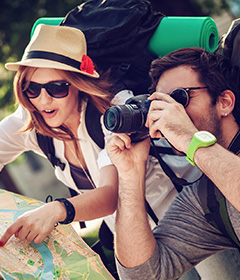Embarking on a journey is more than just visiting new places; it’s about collecting memories, insights, and personal growth. Travel journaling serves as a powerful tool to enhance these experiences, offering a myriad of benefits that extend far beyond the trip itself. From cognitive improvements to cultural immersion, the act of documenting your travels can transform fleeting moments into lasting impressions.
As you traverse unfamiliar landscapes and cultures, your mind becomes a sponge, absorbing a wealth of new information. By putting pen to paper or fingers to keyboard, you’re not just recording events; you’re processing and internalizing your experiences in a profound way. This practice of reflection and documentation can lead to deeper understanding, sharper memories, and even personal transformation.
Cognitive benefits of travel journaling
The cognitive advantages of keeping a travel journal are numerous and significant. When you engage in the act of writing about your experiences, you’re activating multiple areas of your brain, enhancing neural connections and improving cognitive function. This mental exercise can lead to better memory retention, increased creativity, and improved problem-solving skills.
One of the primary cognitive benefits is the enhancement of observational skills. As you journal, you naturally become more attuned to your surroundings, noticing details that might otherwise slip by unobserved. This heightened awareness not only enriches your travel experience but also carries over into everyday life, making you a more perceptive individual overall.
Moreover, the act of journaling encourages critical thinking and analysis. As you reflect on your experiences and attempt to articulate them in writing, you’re forced to process information more deeply, leading to greater insights and a more nuanced understanding of the places and cultures you encounter.
Digital vs. analog journaling methods for travelers
In the modern age, travelers have a choice between traditional pen-and-paper journals and digital platforms for documenting their journeys. Each method has its own unique advantages and considerations, catering to different preferences and travel styles.
Evernote and OneNote for digital travel documentation
Digital platforms like Evernote and OneNote offer versatility and convenience for the tech-savvy traveler. These applications allow you to create multimedia journals, combining text with photos, audio recordings, and even sketches. The ability to sync across devices ensures that your journal is always accessible, whether you’re using a smartphone, tablet, or laptop.
One of the key advantages of digital journaling is the ease of organization. You can tag entries, create separate notebooks for different trips, and search for specific content with just a few clicks. This functionality is particularly useful for long-term travelers or those who frequently embark on new adventures.
Moleskine and leuchtturm1917 for traditional travel diaries
For those who prefer the tactile experience of writing by hand, brands like Moleskine and Leuchtturm1917 offer high-quality journals that have become favorites among travelers. The physical act of writing can be a meditative process, allowing for a deeper connection with your thoughts and experiences.
Analog journals have the advantage of being free from technological distractions. There’s no need to worry about battery life or Wi-Fi connectivity, and the absence of notifications can help you stay present in the moment. Additionally, a physical journal serves as a tangible keepsake, a personal artifact that can be cherished for years to come.
Hybrid approaches: rocketbook and smart pens
For those who want the best of both worlds, hybrid solutions like Rocketbook and smart pens offer an innovative middle ground. These tools allow you to write in a physical notebook while simultaneously digitizing your entries. This approach combines the tactile satisfaction of handwriting with the organizational benefits of digital storage.
Smart pens, in particular, can transcribe your handwritten notes into digital text, making them searchable and editable. This technology bridges the gap between traditional and modern journaling methods, appealing to travelers who appreciate both the old and the new.
Enhancing memory retention through travel writing
One of the most significant benefits of travel journaling is its impact on memory retention. The act of writing about your experiences helps to solidify them in your mind, creating stronger and more lasting memories.
Episodic memory formation in unfamiliar environments
When you travel to new places, your brain is constantly forming episodic memories—detailed recollections of specific events and experiences. By journaling about these moments, you’re essentially reinforcing these neural pathways, making it easier to recall these memories later on.
Research has shown that the act of writing engages multiple senses and cognitive processes, which can lead to more robust memory formation. As you describe the sights, sounds, and smells of a new place, you’re creating a multi-sensory memory that is more likely to stand the test of time.
Sensory detail incorporation for vivid recollection
To maximize the memory-enhancing benefits of travel journaling, focus on incorporating rich sensory details into your entries. Describe the textures of local fabrics, the aromas wafting from street food stalls, or the unique cadence of a foreign language. By doing so, you’re not only creating a more vivid record of your experiences but also increasing the likelihood of being able to recall these details vividly in the future.
Consider using descriptive language that evokes all five senses. For example, instead of simply noting that you visited a market, describe the vibrant colors of the produce, the cacophony of vendor calls, and the feel of sun-warmed cobblestones beneath your feet.
Spaced repetition techniques in travel journaling
To further enhance memory retention, consider incorporating spaced repetition techniques into your journaling practice. This involves revisiting and rewriting key experiences at increasing intervals. For instance, you might write about a particularly memorable event on the day it occurs, then summarize it again a week later, and once more at the end of your trip.
This technique not only helps to reinforce memories but also allows you to reflect on your experiences from different perspectives over time. You may find that your understanding or appreciation of certain events evolves as you gain distance and context.
Cultural immersion and linguistic development via journaling
Travel journaling can significantly enhance your cultural immersion and linguistic development while exploring new destinations. By actively engaging with your surroundings through writing, you create opportunities for deeper understanding and language acquisition.
When you document your interactions with locals, cultural practices, and linguistic nuances, you’re forced to process and internalize these experiences more thoroughly. This active engagement can lead to a more profound appreciation of cultural differences and similarities.
For language learners, journaling in the target language—even if only for short phrases or simple sentences—can be an invaluable practice. It encourages you to use new vocabulary in context, reinforcing your learning and building confidence in your language skills.
Journaling about cultural experiences not only preserves memories but also cultivates empathy and global understanding.
Consider dedicating sections of your journal to local customs, phrases, or cultural observations. This focused approach can help you develop a more nuanced understanding of the places you visit and the people you meet along the way.
Creative writing techniques for engaging travel narratives
Incorporating creative writing techniques into your travel journal can transform your entries from simple logs of events into captivating narratives that bring your experiences to life. These techniques not only make your journal more engaging to read later but also enhance your ability to observe and appreciate your surroundings in the moment.
Descriptive prose for capturing landscapes and landmarks
When describing landscapes and landmarks, strive to paint a vivid picture with your words. Use rich, evocative language that appeals to all senses. Instead of simply stating that a mountain was tall, describe how it pierced the clouds, its snow-capped peak glinting in the sunlight like a diamond.
Employ metaphors and similes to draw comparisons that make your descriptions more relatable and memorable. For example, you might describe a bustling marketplace as “a living, breathing organism, with streams of people flowing like blood through its veins.”
Character sketches of encountered individuals
Your travel journal isn’t just about places; it’s also about the people you meet. Create brief character sketches of interesting individuals you encounter. Focus on unique mannerisms, distinctive features, or memorable interactions. These personal touches can bring your journal entries to life and help you remember the human connections that often make travel so meaningful.
For instance, instead of simply noting that you met a friendly shopkeeper, describe their weathered hands, the crow’s feet that appeared when they smiled, and the way they gestured animatedly while sharing local legends.
Dialogue integration for authentic local interactions
Incorporate snippets of dialogue to capture authentic local interactions. Even if you can’t remember exact words, paraphrasing conversations can add depth and authenticity to your journal entries. This technique is particularly effective for preserving the flavor of local accents, colloquialisms, or memorable phrases you encounter.
Consider using quotation marks to set off direct speech, making your journal entries more dynamic and easier to read. For example: The old fisherman squinted at the horizon and said, “The sea, she’s restless today. Best to stay ashore and mend your nets.”
Metaphor and simile usage in travel descriptions
Metaphors and similes are powerful tools for creating vivid, memorable descriptions in your travel journal. These literary devices allow you to draw unexpected comparisons that can make your writing more engaging and help readers (including your future self) connect more deeply with your experiences.
For example, you might describe a serene mountain lake as “a mirror held up to the sky, reflecting the clouds and surrounding peaks with perfect stillness.” Or you could compare the experience of navigating a crowded bazaar to “swimming through a sea of humanity, each person a wave carrying their own story and purpose.”
Data analysis and pattern recognition in Long-Term travel journals
For long-term travelers or those who frequently embark on new adventures, travel journaling can evolve into a rich source of personal data and insights. By consistently documenting your experiences, you create a valuable dataset that can reveal patterns and trends in your travel preferences, behaviors, and personal growth over time.
Consider creating a system for tracking certain aspects of your travels, such as:
- Favorite accommodations and their characteristics
- Preferred types of cuisine encountered
- Most memorable cultural experiences
- Challenges faced and overcome
- Personal growth milestones achieved through travel
By analyzing this data, you can gain insights into your travel style, identify areas for personal development, and make more informed decisions for future trips. For instance, you might notice a pattern of particularly enjoyable experiences in certain types of destinations or a recurring challenge that you can prepare for in advance.
To facilitate this analysis, consider using a combination of qualitative descriptions and quantitative ratings in your journal entries. You might, for example, rate each accommodation on a scale of 1-5 for factors like comfort, location, and value, alongside your written observations.
| Aspect | Rating (1-5) | Notes |
|---|---|---|
| Comfort | 4 | Plush bed, quiet room, but limited hot water |
| Location | 5 | Central, walking distance to main attractions |
| Value | 3 | Slightly overpriced for amenities offered |
Over time, this structured approach to travel journaling can yield valuable insights, helping you to optimize your travel experiences and track your personal growth as a global explorer. By recognizing patterns in your preferences and experiences, you can make more informed decisions about future destinations, accommodations, and activities that align with your personal travel style and goals.
Ultimately, the practice of travel journaling offers a multitude of benefits that enhance not only your travel experiences but also your personal growth and cognitive abilities. Whether you choose digital or analog methods, the act of documenting your journeys can lead to richer memories, deeper cultural understanding, and valuable personal insights. By incorporating creative writing techniques and structured data analysis, you can transform your travel journal into a powerful tool for self-discovery and lifelong learning.


